Berndnaut Smilde conducts elementary particles of water and smoke to create clouds riddled with sculptural complexity. Suspended within spaces whose walls are dense with history, materiality, and architectural intrigue, Smilde creates an atmospheric artwork that would become ephemeral if not for the photographic documentation. Belonging to an ongoing body of work called the “Nimbus” series, the artist intervenes in a particular space and forever changes the essence of the environment. While the clouds may only last for a matter of seconds, they are imbued with an undeniable sense of permanence long after their remnants have dissipated. In his latest solo exhibition, “Traumbild Senden,” (an anagram of the artist’s name) at Museum gegenstandsfreier Kunst in Otterndorf, Germany, Smilde further examines ways to arrange and rearrange environmental elements, demonstrating the fluidity of meaning and embracing the constant of change.
In our first interview “Manufactured Phenomenon,” in 2013 we were introduced to the “Nimbus” Series. In what ways has your process of creating atmospheric clouds evolved? Have you implemented new techniques that influence the density, scale, shape, or duration of the clouds? Have these changes helped to make the clouds on a larger scale?
The process remained basically the same. I still make use of smoke and water and they live for a short moment, but I’m more experienced now. I can control them better and this resulted in that over time the clouds got denser and larger in size. During the Armory Show in New York in 2018, I made an installation that produced a cloud automatically, and for the upcoming “World Expo 2020,” in Dubai, I am working towards a large-scale presentation for the Netherlands Pavilion.
How do you appropriate the “Nimbus” Series? Do you relate to it as a performance or site-specific installation? Without the photographic documentation, it would be an ephemeral work of art. What elements are the photographs missing from the actual experience of watching the clouds unfold in person?
I see the clouds as temporary sculptures made for a specific location. Although I’m creating the work on-site I’m not performing the cloud. The cloud is the actual artwork. As the clouds aren’t durable and fall apart the moment they grow, the work is captured in a photograph which functions as the document of something that took place in a specific location and is now gone. You could say that the work is not so much the photograph itself as the scene that it evokes. Art historian Laura van Grinsven described it very nicely, that “through the photograph, we are re-living the moment in our minds again making the cloud even more important in its absence than its presence.”

Photograph by Cassander Eeftinck Schattenkerk
Image courtesy of the artist and Ronchini Gallery
What methodology do you employ to prepare for the creation of a work in the “Nimbus” series?
Sometimes there’s quite a bit of preparation, as you can imagine museums that are air-conditioned and have smoke detectors have to be shut off for the moment and public access is closed so that no one can walk through the scene. Mostly it takes a couple of days to create a work and I always work with a professional photographer to capture the cloud. When I arrive I take a fair amount of time to find the setting I want, elements that should be in the frame, or the light that I want to capture. Then I usually test different setups with the machines and light situations, to see how the smoke reacts in the space and make adjustments. After every cloud, we need to clear the space from smoke and start again. Every cloud and light situation is unique. We shoot tens of clouds and in the end select one to be the work.
What is the average duration that a cloud can exist in a space before it disappears?
This can be very different depending on the air circulation but average about 10 seconds.

Photograph by Cassander Eeftinck Schattenkerk
Image courtesy of the artist and Ronchini Gallery
What architectural elements do you look for when selecting a location to create a piece for the “Nimbus” series? What locations are used in the series of images presented in this exhibition?
Work starts with a location. There are still a few buildings on my list or sometimes I hear about a specific place. I like spaces with a sense of materiality, unusual architectural structures, and features such as tiles, colors, and craftsmanship or spaces that have traces of former use. At the moment I’m working on a museum series in which I try to bring out the “ideal” aspects of a space that is solely created for presenting culture. Recently I worked in one of my favorite buildings in the Netherlands: the Kunstmuseum Den Haag which is designed by architect H.P. Berlage. The building designed in the ’30s has a kind of futuristic atmosphere and is totally symmetrical. It acts as a great counterbalance to the uncontrollable aspect of the cloud. This is one of the works in the show. The exhibition features three “Nimbus” works made in museums and one in a former industrial space that will turn into a cultural destination soon. Another piece presented in the exhibition was shot at the Baths of Diocletian, at the National Roman Museum. In this work, time plays an important role. The architecture as well as the statues and sarcophagi are all over 2000 years old which is in contrast to the intangible fleeting cloud. One time a day for half an hour the sun came in through a window on the side creating a beautiful light situation. I really wanted to capture this moment. Together with the architecture, materiality, and colors, it provides a classical and painterly expression to the work.
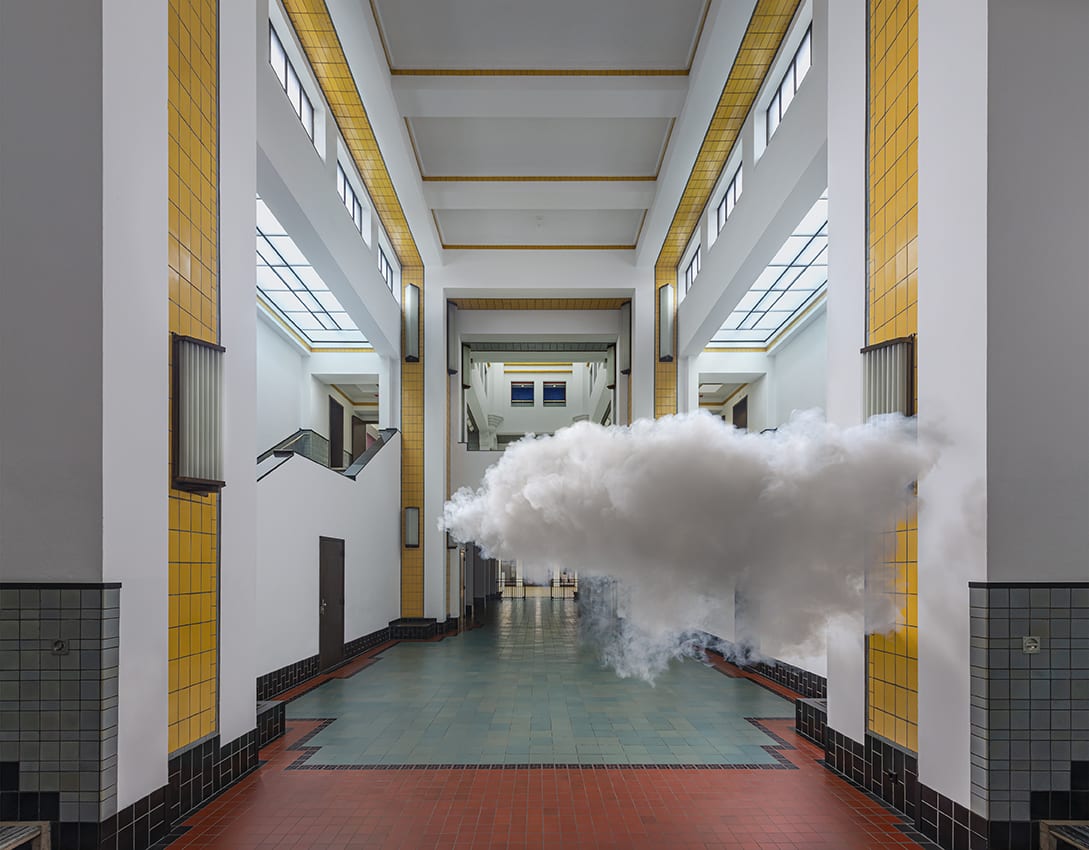
Photograph by Cassander Eeftinck Schattenkerk
Image courtesy of the artist and Ronchini Gallery
How many photographers do you work with to document the “Nimbus” series? What photographic elements are most important to you to faithfully document the moment?
Mostly I work with the same photographer: Cassander Eeftinck Schattenkerk. This started as he was documenting exhibitions at the art space in the former chapel of Hotel Mariakapel where I made my first real cloud. He was familiar with space, the light, and we have worked ever since on many locations. But when abroad I also work with other photographers and I like the idea that they all have their own expertise towards approaching space and light. The light is the most important element in the moment when shooting, and this will change during the day so we are always adjusting.
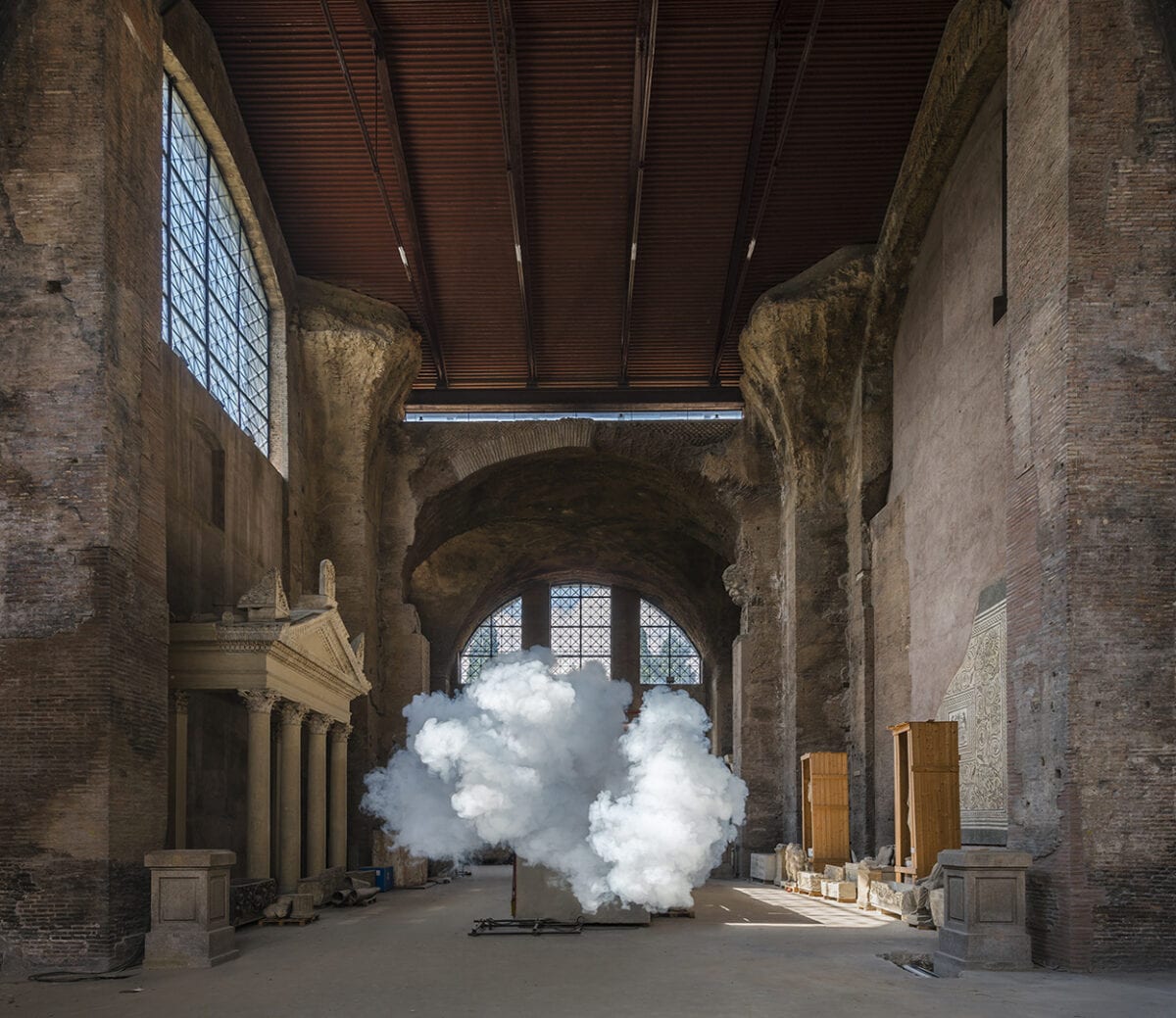
Photograph by Cassander Eeftinck Schattenkerk
Image courtesy of the artist and Ronchini Gallery
Your forthcoming solo exhibition at Museum Gegenstandsfreier Kunst (Museum for Object Free Art) is titled “Traumbild Senden,” which is an anagram of your name Berndnaut Smilde. Changing the order of the letters not only speaks to the arbitrary nature of language but reflects a philosophy integral to your artistic practice- putting elements in a different order so that a new meaning occurs. Why is changing the order of elements so important?
Changing the order of how we perceive things is something I tend to do, by bringing a cloud inside a space or presenting a rainbow upside down you take elements out of their natural context and could read them differently. A sign of hope that a rainbow stands for could become something else. My name is a constructed name from both my parents’ names, by putting these letters in a different order new meaning occurs, “Traumbild Senden” is one example, but there is also “Dismantled Ruben,” “Builded Remnants,” or “Timberland Dunes.” These anagrams reflect my identity and at the same time relate to the act of building and my work but all in a different way.
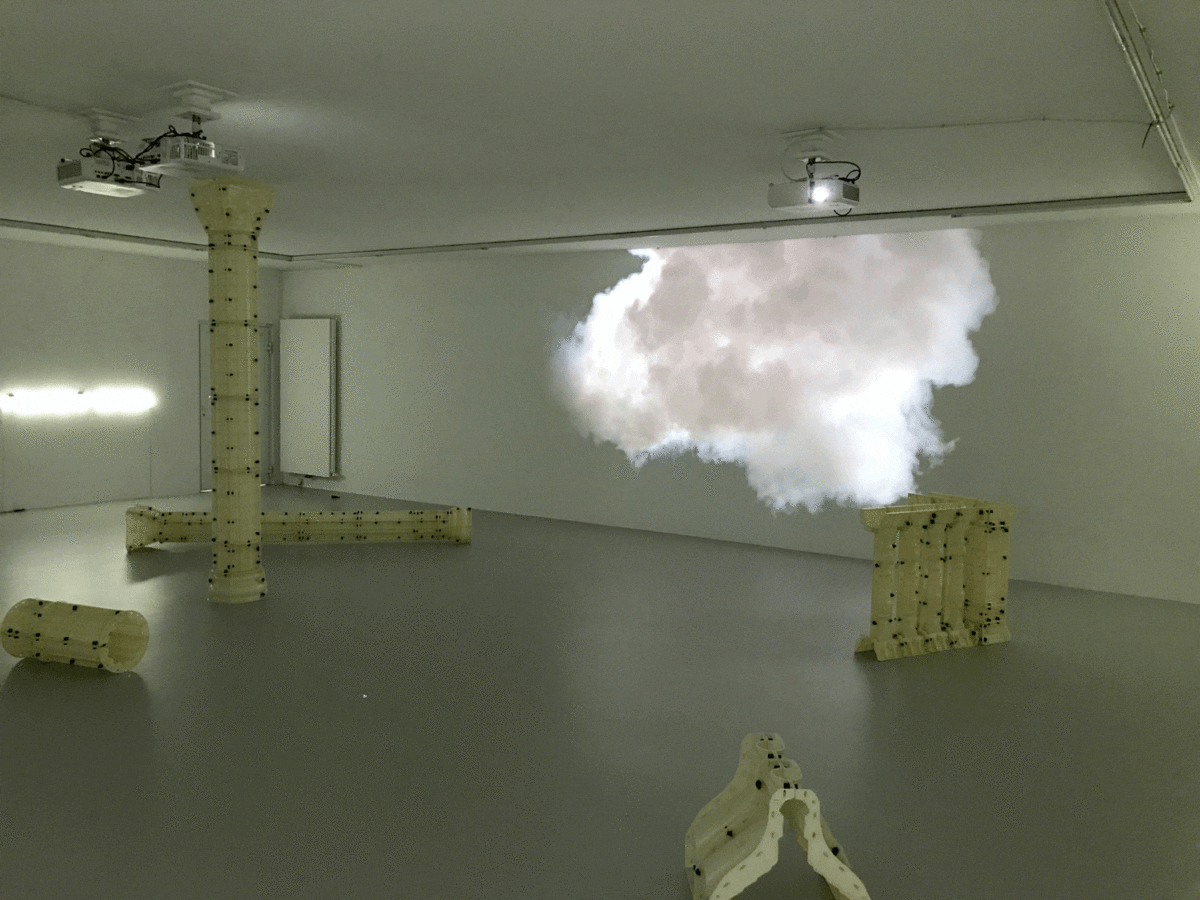
Image courtesy of Berndnaut Smilde
What is the dialogue between the video installation, sculptures, and neon wall works and the “Nimbus” series?
They are individual artworks that resonate with my affection and romantic ideas about the landscape, my position as a viewer, and temporality but in different materiality making visual connections that work together well, enhancing an overall narrative when going around the building.
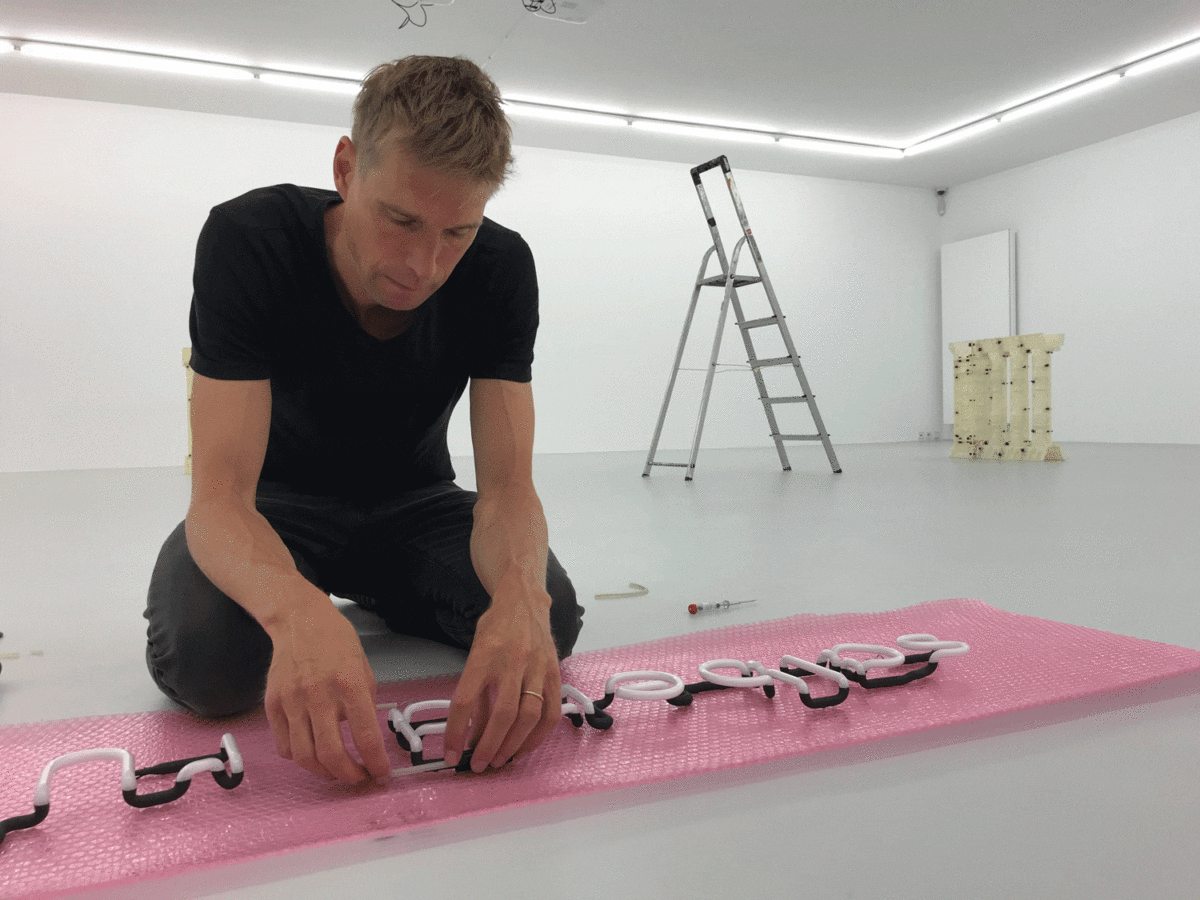
Photograph by Annegret Kellner
Image courtesy of the artist and Ronchini Gallery
How did you determine the blueprint of the exhibition? On the first floor, you present a room with video installations combined with architectural ‘props’ and neon pieces that relate to the act of building that the audience can walk through. What images inspired the video installation? Are you inviting the audience into your creative process by creating an immersive space?
The ground floor exhibition area is one large open space that you have to cross through to get to the first floor. There are six videos on three walls that differ in duration so the audience has to choose where to focus on and will sometimes miss out on what’s happening behind him. The videos show man-made clouds emerging out of a void slowly growing and falling apart again. These clouds were shot with a high-speed camera creating slow-motion visualizations of how these clouds grow, change shape, and reflect light. In the middle there are plastic molds of architectural forms for casting concrete pillars and balusters, creating an architectural setting that could be seen as a ruin, and at the same time are hollow shells used for constructing and reproduction. The neon signs are anagrams of my name in German and English, that refer to the building as well and what is left behind.
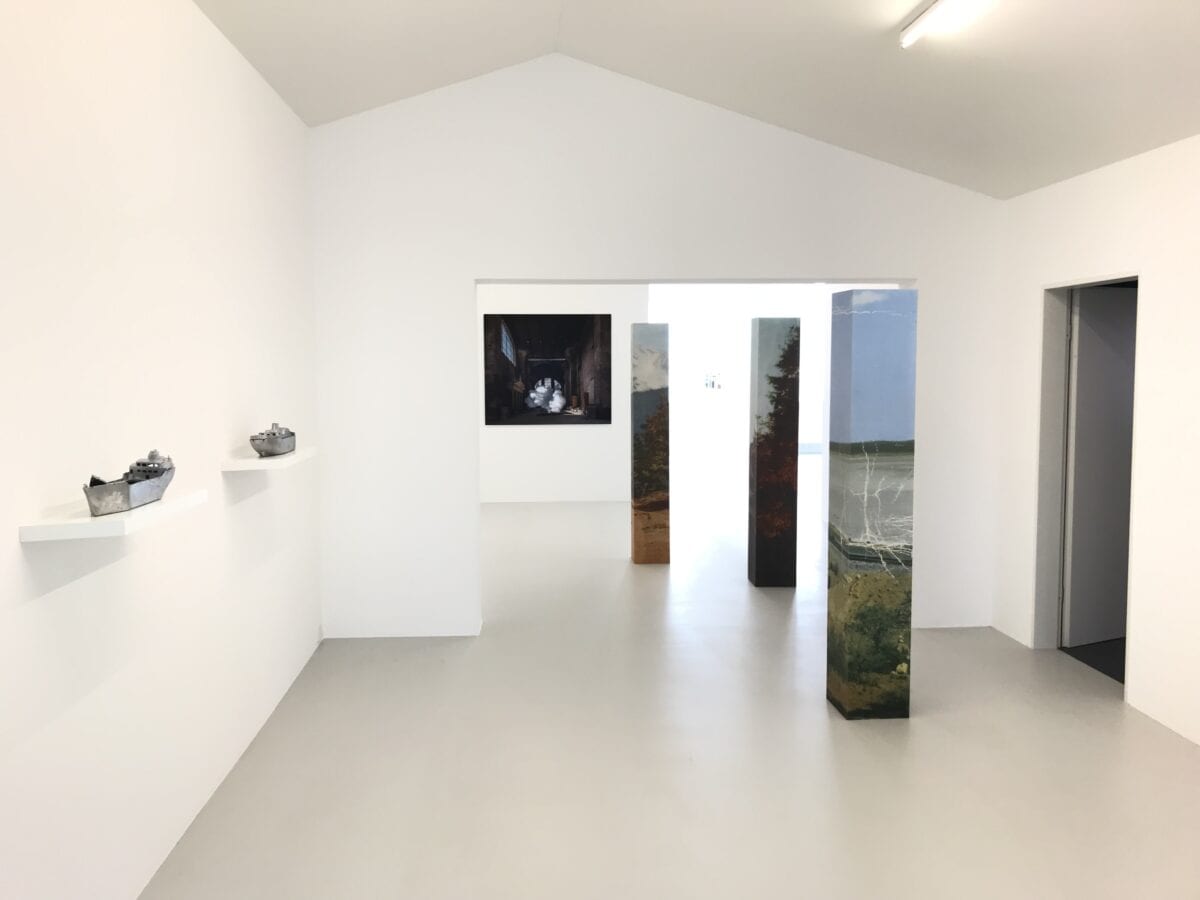
Image courtesy of Berndnaut Smilde
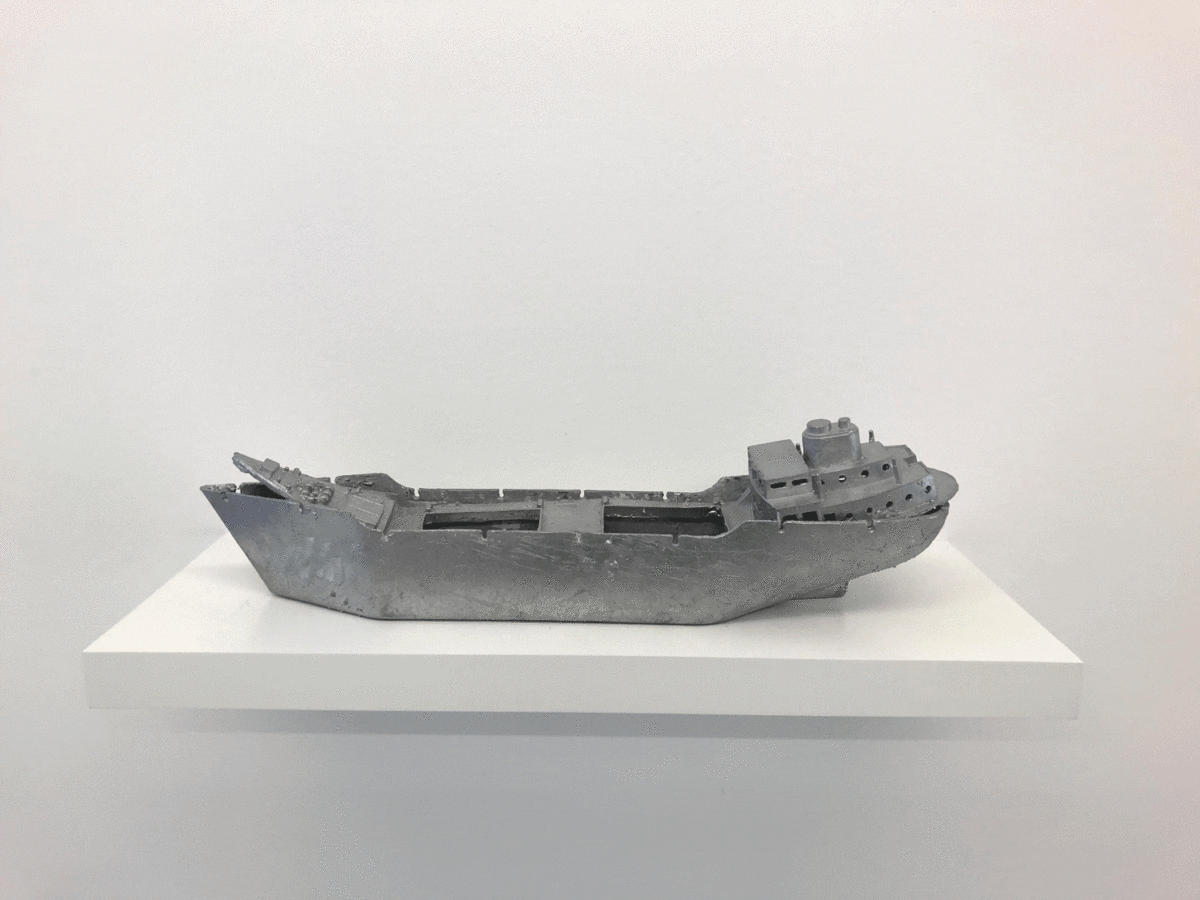
Aluminum
50 x 10 x15 cm
Image courtesy of the artist and Ronchini Gallery
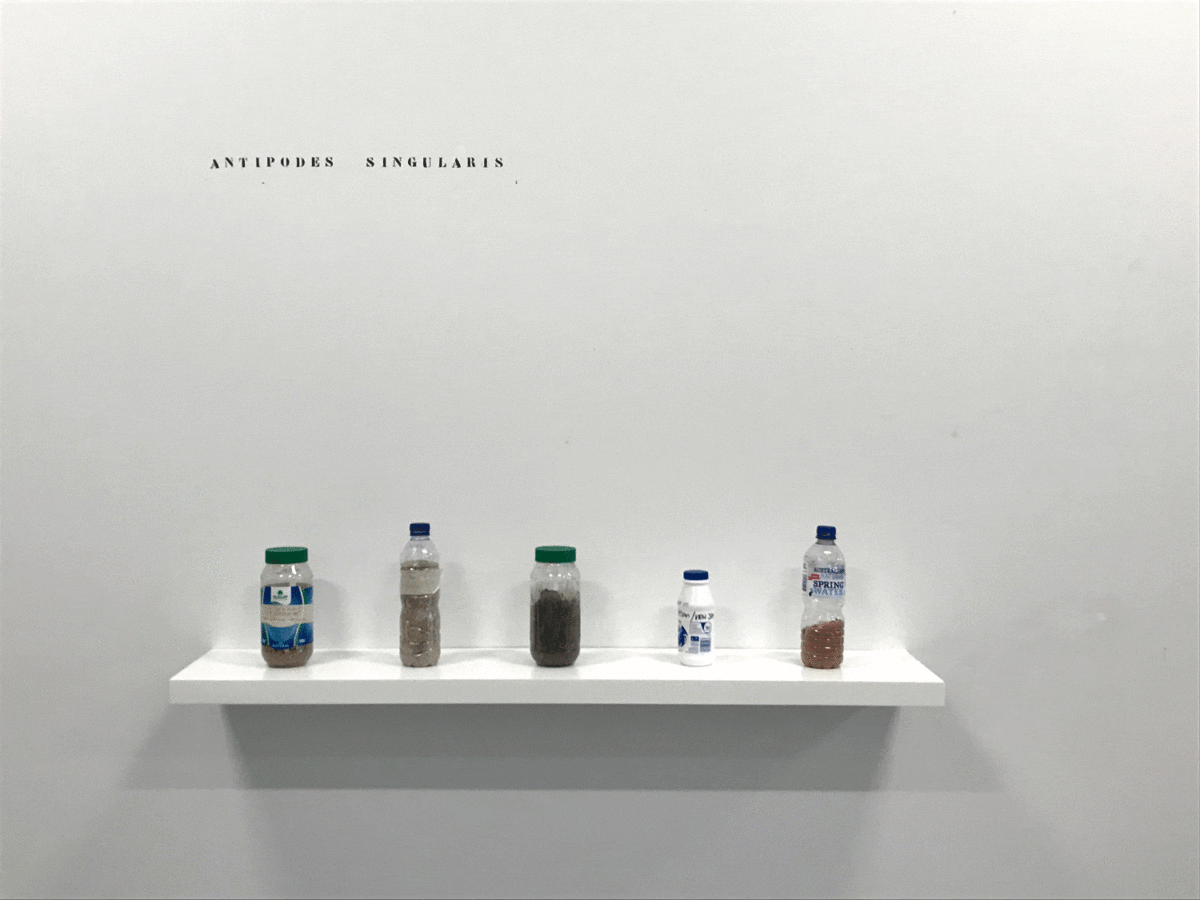
Bottles with sand from 5 antipodes on the southern hemisphere
Image courtesy of the artist and Ronchini Gallery
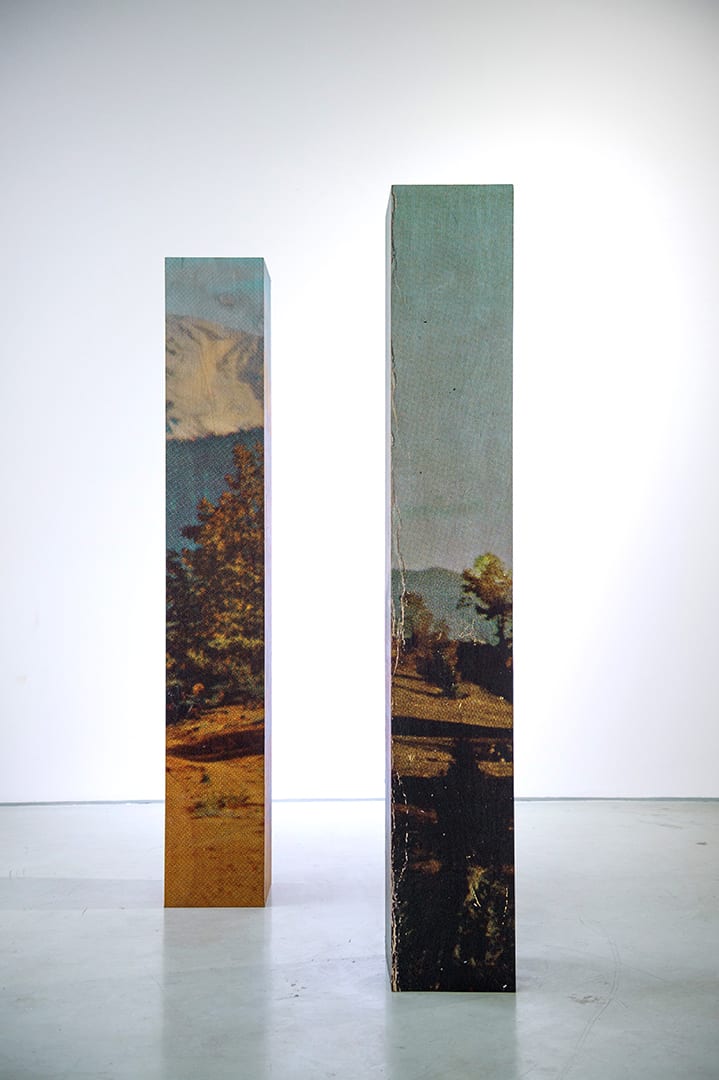
Print on wooden columns
190 x 29 x 29 cm
Image courtesy of the artist and Ronchini Gallery
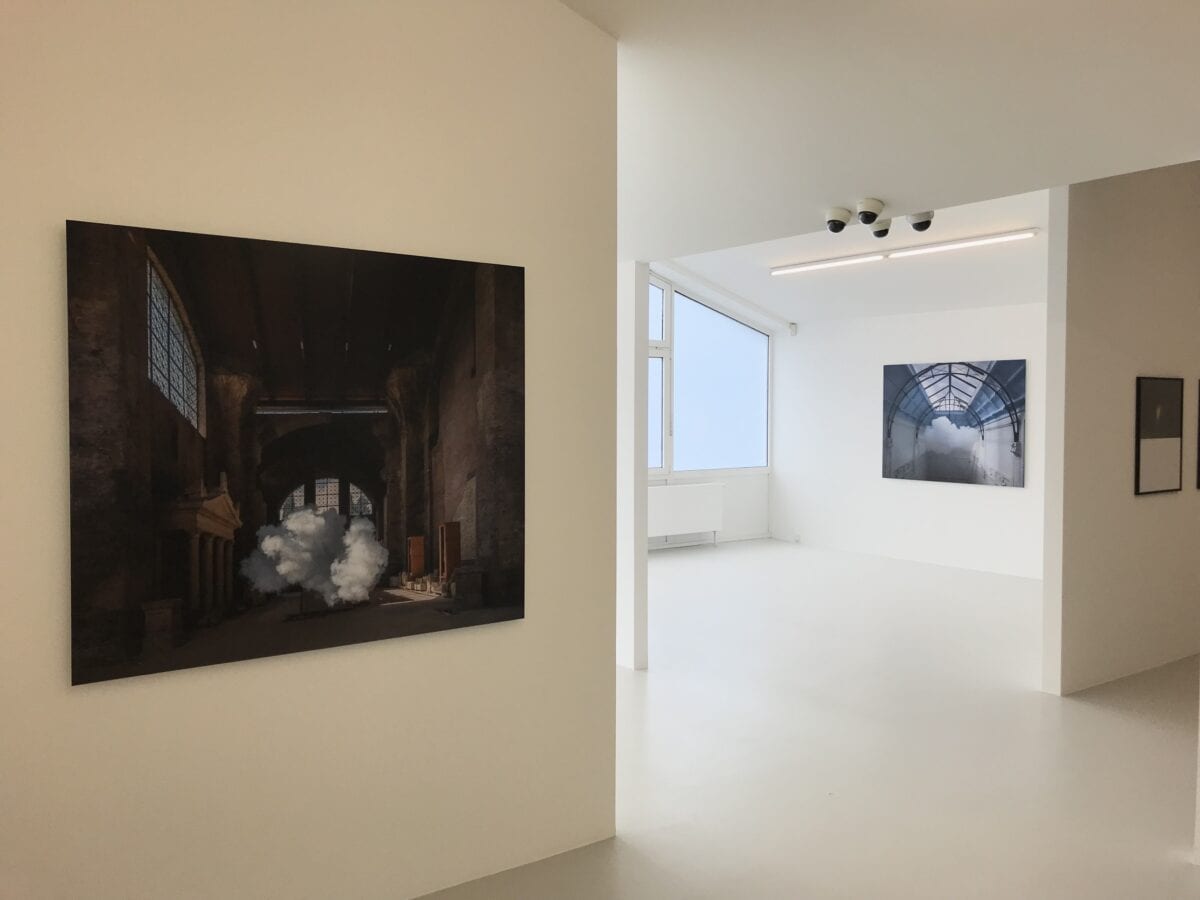
Image courtesy of Berndnaut Smilde
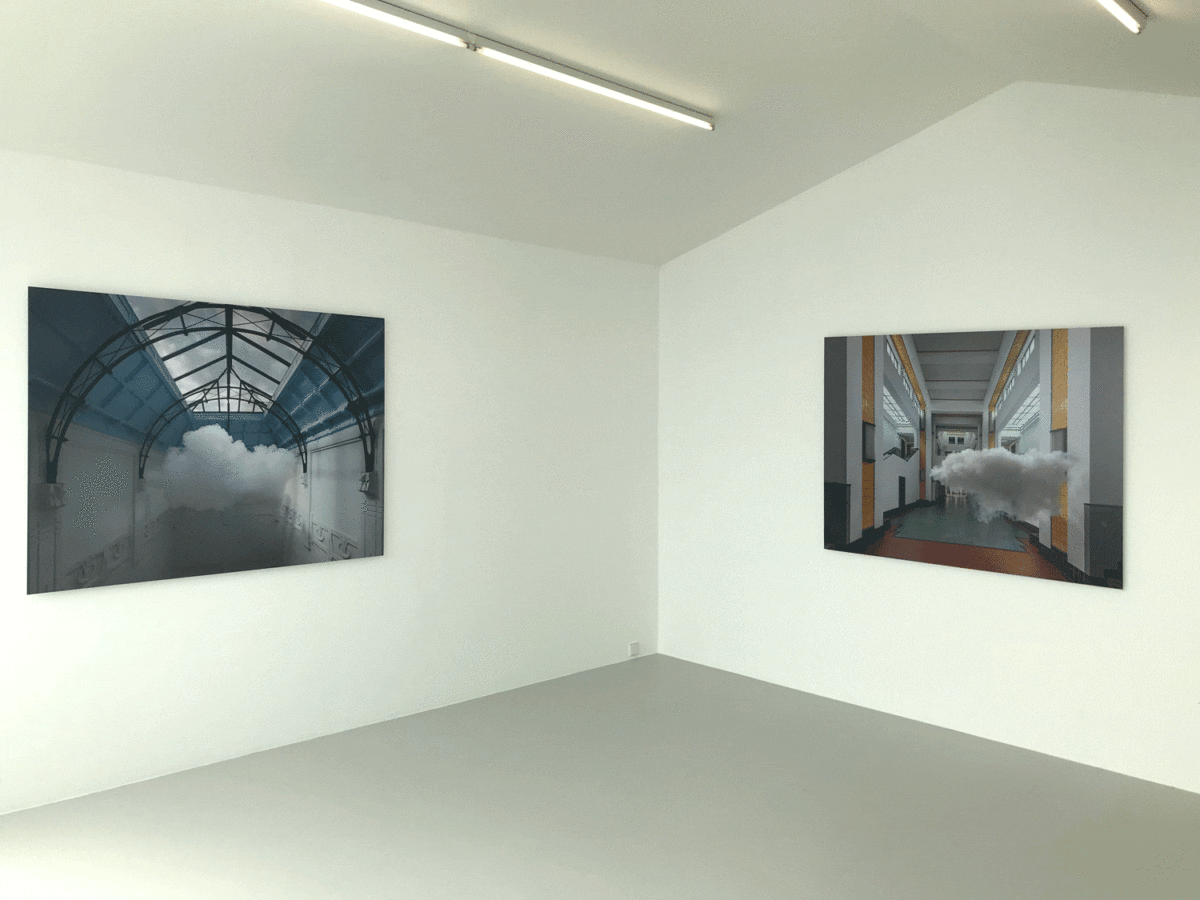
Image courtesy of Berndnaut Smilde

Image courtesy of Berndnaut Smilde
On the second floor you are presenting images from the “Breaking Light” series. The capture of refracted light speaks to the fragility of the moment. What inspired this new body of work?
The “Breaking Light” series is a continuous attempt to break light at a large scale. It started with the idea of using a lighthouse by placing a prism in front of the light to project a rainbow onto the surrounding. I wanted to impose a natural phenomenon onto the surrounding like a temporary hack in the landscape. During a residency at BMoCA in Colorado, I worked together with a scientist from NCAR (National Center for Atmospheric Research) on the development of a prototype prism, which I used in several projects. A rainbow can be seen as a sign of perfection and promise, but what does it mean if it just hits your house or is presenting itself upside down? I like to question these values. A rainbow is even more fleeting than a cloud, it’s not even physical, it only appears in our eyes through the refraction of light. Eventually, I got permission to use a lighthouse. This triggered the idea to refract the light of lighthouses in a series everywhere I go. Every lighthouse is unique and has its own light character belonging to that specific location. So far I managed to refract the light of two lighthouses. That last attempt in Uruguay didn’t work, unfortunately.

Image courtesy of Berndnaut Smilde
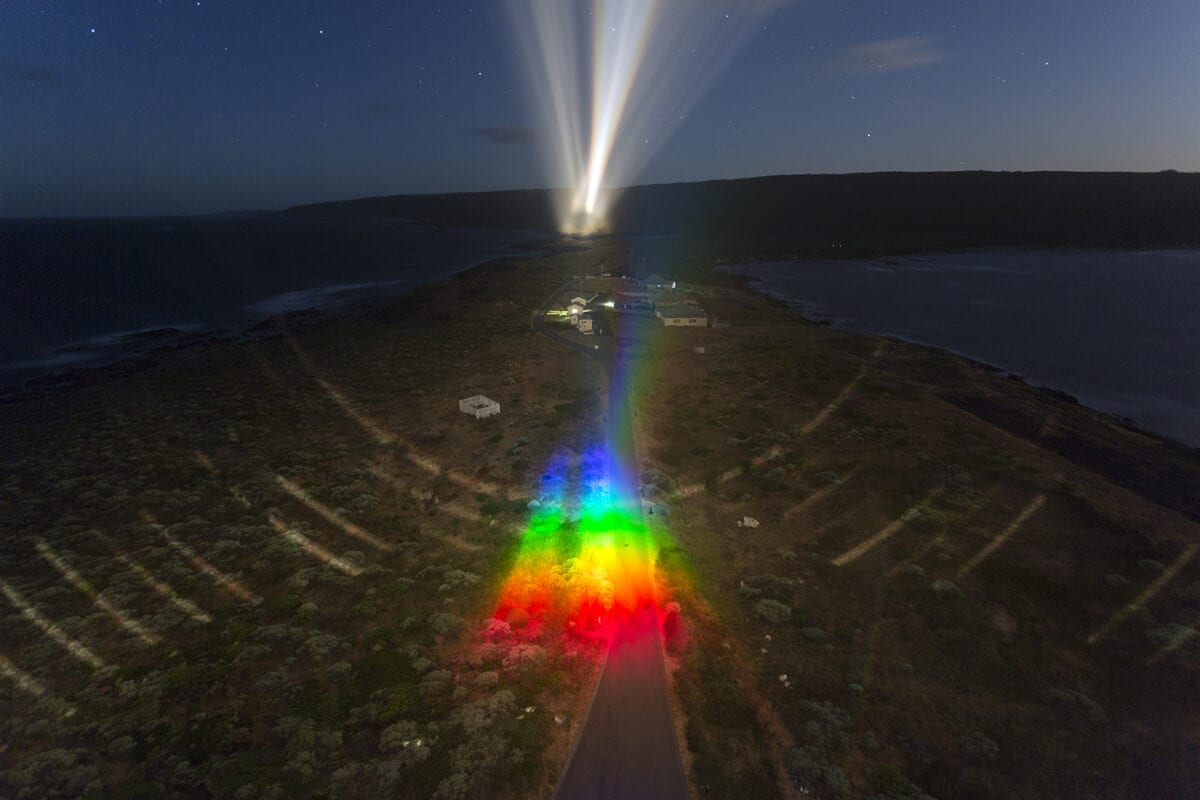
Photograph by Bewley Shaylor
Image courtesy of the artist and Ronchini Gallery

100 x 50 x 50 cm
Image courtesy of the artist and Ronchini Gallery
The exhibition includes immersive, video, photographic, and architectural props. How do you hope the viewer will interact with these elements and piece them together? The exhibition is particularly special because it marks a return to experiencing art in real life. What feeling or message do you hope that the viewer encounters in this exhibition?
I’m very happy to physically work on an exhibition again. It’s not so often that you have the opportunity to bring different bodies of work together and the way the building is constructed made sense for me to lead the viewer along with distinctive aspects of my work. The ground floor open large space visualizes the general concept of the exhibition. Upstairs there are five cabinets where you come across that depict sculptures, photographs, models, and antipodal sand. At first, it might seem contradictory to find many objects in a museum of object-free art, but we need a form to tell a story and the exhibition is about the idea and stories these objects trigger.
Berndnaut Smilde’s solo exhibition, ‘Traumbild Senden,” at Museum gegenstandsfreier Kunst in Otterndorf, Germany and will be on view from July 4- September 26, 2021
Featured Image:
Berndnaut Smilde, “Nimbus Kunstmuseum Hal,” 2021
Photograph by Cassander Eeftinck Schattenkerk
Image courtesy of the artist and Ronchini Gallery
All images courtesy of the artist and Ronchini Gallery © 2021
